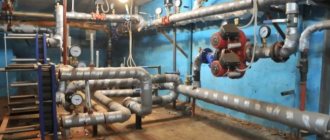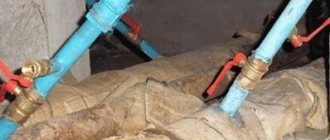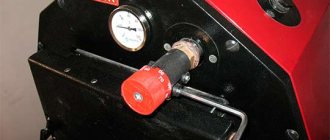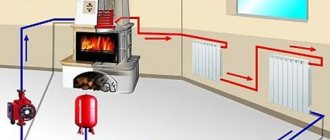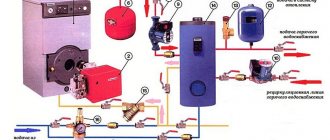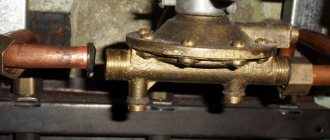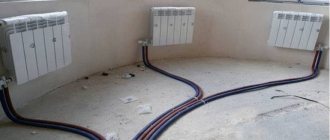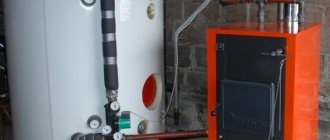Heat consumption for ventilation
To find out how much heat a private house loses as a whole, you need to add up the losses of all its rooms. But that's not all, because it is necessary to take into account the heating of the ventilation air, which is also provided by the heating system. In order not to go into the jungle of complex calculations, it is proposed to find out this heat consumption using a simple formula:
Qair = cm (tв - tн), where:
- Qair - the required amount of heat for ventilation, W;
- m is the amount of air by mass, defined as the internal volume of the building multiplied by the density of the air mixture, kg;
- (tв - tн) - as in the previous formula;
- с - heat capacity of air masses, taken equal to 0.28 W / (kg ºС).
To determine the heat demand of the entire building, it remains to add the value of QTP for the house as a whole with the value of Qair. The power of the boiler is taken with a margin for the optimal operating mode, that is, with a coefficient of 1.3. An important point must be taken into account here: if you plan to use a heat generator not only for heating, but also for heating water for hot water supply, then the power reserve must be increased. The boiler must work effectively in 2 directions at once, and therefore the safety factor must be taken at least 1.5.
Control module
The heating system of the VAZ-2107 is controlled by a special module located at the bottom of the dashboard. Its design includes three levers and a heater fan mode switch.
The uppermost lever provides control of the stove tap. In the extreme left position, it is closed, and the coolant moves bypassing the heating radiator. If the switch is moved all the way to the right, the refrigerant will begin to flow into it in full, heating the air to the maximum.
The middle lever allows you to close-open the air inlet cover. In the left position, it will be completely closed, and outside air will not be able to enter the passenger compartment. The lid will fully open when we move the switch to the far left position.
The heating system of the VAZ-2107 provides for the distribution of air flows for blowing the windshield and front side windows. It is carried out using the lower lever. In the right position, the air is directed to the side windows, in the left - to the windscreen.
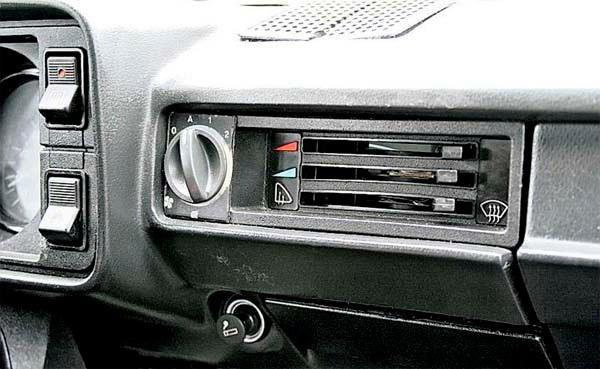
The heater valve, the air intake cover, as well as the dampers that redirect the air flows are driven by cables.
The fan mode switch is located to the left of the control levers. It has four positions in which the fan:
- switched off;
- works at first speed;
- at second speed;
- at the third speed.
Nuances and subtleties
Those who have a desire to make homemade heating should remember that only those types of pipes should be used that have a small diameter, since only they can maintain a high water temperature and effectively create and maintain the required temperature regime in the Russian climate.
However, they also have their drawbacks. In particular, the installation of hot water heating, due to the small diameter of the pipes, cannot be carried out without preliminary overhaul of the entire room. In addition, as for the water heating system itself, it requires constant heating of the coolant.
Therefore, if you forgot to drain the water from the pipes of your private house in the winter season and left it for a long time, then you should expect trouble, because under the influence of low temperature the pipes can simply break.As a result, upon your return, you will be forced to repair the entire water heating system, since the main part of the pipeline will be damaged.
But even if you do not forget to drain water from heating pipes with a small diameter, they can still suffer from the effects of corrosion, since the presence of air will take place, which will lead to the formation of internal condensation on the walls of the pipeline.
Water heating of a country house is an affordable cost of materials for installation and further operation, as well as good results in creating warmth and comfort in the house.
Calculation of a gravitational heating system
The main indicators of the gravitational heating system
Before proceeding with the installation of pipes and heating devices, it is necessary to calculate the parameters of the entire system. For this, hydraulic characteristics are calculated, which will subsequently affect the selection of the optimal pipeline diameter. Before calculating a gravitational heating system, you need to know the basic parameters. They will be required to calculate the actual value of the circulating head (Рц):
- Distance from the center of the boiler to the center of the heater (h). The larger it is, the better the fluid circulation will be. Therefore, when installing a gravitational heating system with your own hands, it is recommended to mount the boiler at the lowest point of the house - the basement;
- Circulation pressure of the heated (Pr) and cooled (Po) coolant.
Circulating pressure value
Regardless of whether the gravitational heating system is calculated for two-story or one-story houses, the value of the latter parameters directly depends on the difference in water temperature. This data can be taken from tabular data.
For example, with a value of h-4 m and a temperature difference of 20 ° (80/60), gravitational heating will have a pressure of 4 * 112 = 448 Pa. For further calculations, it is recommended to use specialized software systems that take into account all the parameters of a closed-type gravitational heating system.
Often the diameter of the pipe connected to the outlet of the boiler must be DN 40 or DN 50. This will ensure minimal losses arising from the friction of water against the pipe walls.
Another feature is the difference in coolant temperatures. The larger it is, the higher the circulating pressure. Therefore, in addition to the uniform distribution of heat over the heating devices, during the design of the gravitational heating system, you yourself need to ensure the minimum temperature of the liquid before entering the boiler heat exchanger.
Types of water heating systems in a private house
There are several types of hot water heating for private houses. Here we mean standard heating systems with radiators, underfloor heating and baseboard heating. Individual types can be combined with each other, which allows you to achieve efficient heating. For example, ordinary radiators are installed in bedrooms and living rooms, and heated floors are often installed in bathrooms and toilets - an excellent solution for those who cannot stand the cold and do not like cold tiles. Let's take a look at the individual types of heating and their advantages.
Radiator
Radiator heating systems are timeless classics. The principle of their operation is to transfer heat from the coolant through the radiators installed in the premises. Such heating systems are installed in the overwhelming majority of buildings for various purposes - in residential, industrial, administrative, business and many others. They are relatively easy to install - just stretch the pipes and connect radiators to them.
Previously, water heating in a private house provided for the installation of bulky cast-iron radiators.Over time, they were replaced by lighter and thinner steel radiators made of corrosion-resistant steel. Later, aluminum batteries were born - they are lightweight, cheap and durable. For a private house, this is the most ideal battery option.
The main advantage of radiator systems is that no concrete screeds need to be poured to install them. The entire installation is reduced to the installation of the boiler and radiators with their subsequent connection. Radiators provide effective heating of the premises and do not violate the interior design, especially if they are modern aluminum multisectional batteries.
Warm floor
Water floor heating in a private house can work both independently and in auxiliary mode. In an independent mode, the need to lay pipes with radiators disappears, and all the heat is emitted by the floors. Thanks to this, children can play safely on such floors, they will not be blown through and will not go through. Are your feet constantly freezing? Then you will definitely like the always warm floors. In auxiliary mode, they work as an addition to radiator systems.
Underfloor heating systems are good in kitchens, bathrooms and toilets. where the ever-cold tiles often lie on the floor. Heating pads will help keep your floors warm and comfortable. For example, in the bathroom, you no longer have to stand with bare feet on cold tiles. The same goes for the toilet. If you have a tiled floor in your kitchen, feel free to install underfloor heating systems here too. Another place where a warm floor will become an attribute of comfort is the bedroom - you must admit that it is not pleasant to crawl out from under a warm blanket and become your heels on cold floors.
Underfloor heating is characterized by a low coolant temperature, not exceeding +55 degrees, which allows you to create economical heating systems. But the need to make concrete screeds and pass through walls and door frames is a significant disadvantage. It is best to consider the need to install the system even at the stage of building a house.
Skirting boards
Modern heating systems, built on the basis of classic aluminum radiators, differ in that the heat from them only spreads upwards - due to natural convection. As a result, all the warm air rises, and cold air enters in its place. There is nothing surprising in the fact that households start to feel cold feet. The only plus is the absence of cold from the windows, as it is carried away by convection to the ceiling. But what about heating? Do not lower the radiators to the floor?
The way out of the situation is skirting heating systems. Small-sized radiators made of brass or aluminum are used here. The coolant is supplied using small diameter plastic pipes. The system is complemented by taps, air drains and other necessary accessories.
All this is laid in a special plastic baseboard - the air that gets here heats up and heats the walls on top. Further, the room is warmed by infrared radiation from heated walls and floors. There are no drafts blowing across the floor in heated rooms. Here, not only the walls are warmed up, but also the floors themselves, making the rooms warm and comfortable.
The advantage of skirting board heating is that it can be installed at any stage, even after the completion of construction. Disadvantages - the high cost of installation and a bunch of requirements for the placement of baseboards and other elements. Simultaneous installation of all types of the described systems is also allowed.
Diy heating schemes in a private house
How effective the heating will be depends on the characteristics of the circuit being installed. The heating scheme in a private house with your own hands can be implemented in different ways.We suggest that you familiarize yourself with the possible options in order to choose the best option.
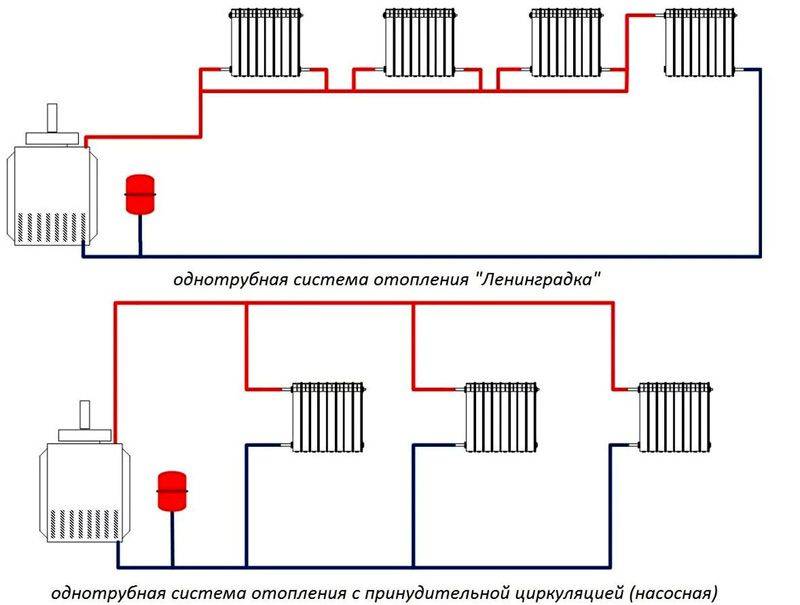

You can always choose the right option
Diagram of a one-pipe heating system of a private house with your own hands
The one-pipe scheme assumes that the coolant from the boiler begins to move along a single line, and then returns along it. Radiators are connected to the line at both ends. A properly mounted one-pipe heating system of a private house with your own hands works as follows:
- the coolant heats up to + 75 ÷ 85 ° C and begins to move through the pipeline. Having reached the first radiator, part of the hot water fills the battery, and the rest continues to move through the pipes;
- passing through the radiator and giving off heat to the surrounding space, the water mixes with the coolant, reducing its temperature by a couple of degrees;
- on the next radiator, the situation is repeated. As a result, significantly cooled water is supplied to the last battery, which reduces the amount of heat given off.
The scheme and procedure for installing one-pipe heating involves building up a section of radiators, starting from the second from the boiler, in order to ensure uniform heating of all rooms of a private house. Water heating works quite efficiently if it contains no more than 5 batteries. In a multi-storey building, several risers are often mounted. Such a vertical scheme assumes the presence of stable working 3 ÷ 4 batteries.
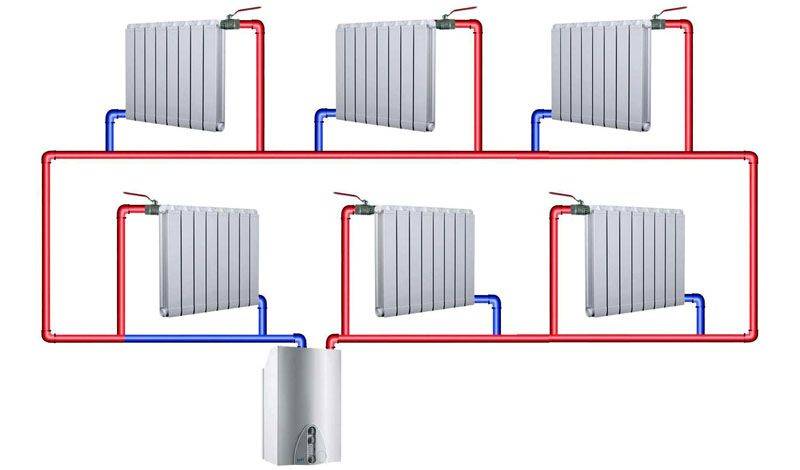

One-pipe model is not always effective
Diagram of a two-pipe heating system
A stable and reliable option that provides a heating medium heated to the same temperature to radiators located in different rooms. Heated water moves through one pipe, and cooled water returns through another.
Depending on the selected wiring, a two-pipe scheme can be:
- Dead-end. The coolant supplied through the corresponding branch fills all radiators, and returns on the reverse. Balancing ensures uniform heating of all batteries;
- Passing. Loop-shaped heating scheme of a country house.When performing installation with your own hands, you should ensure that the coolant moves along the main and return branches in the same direction. Suitable for a sufficiently long contour;
- Collector. A suitable option for a large private house. For powering each radiator, a separate two-pipe branch is used, connected to the distribution manifold.
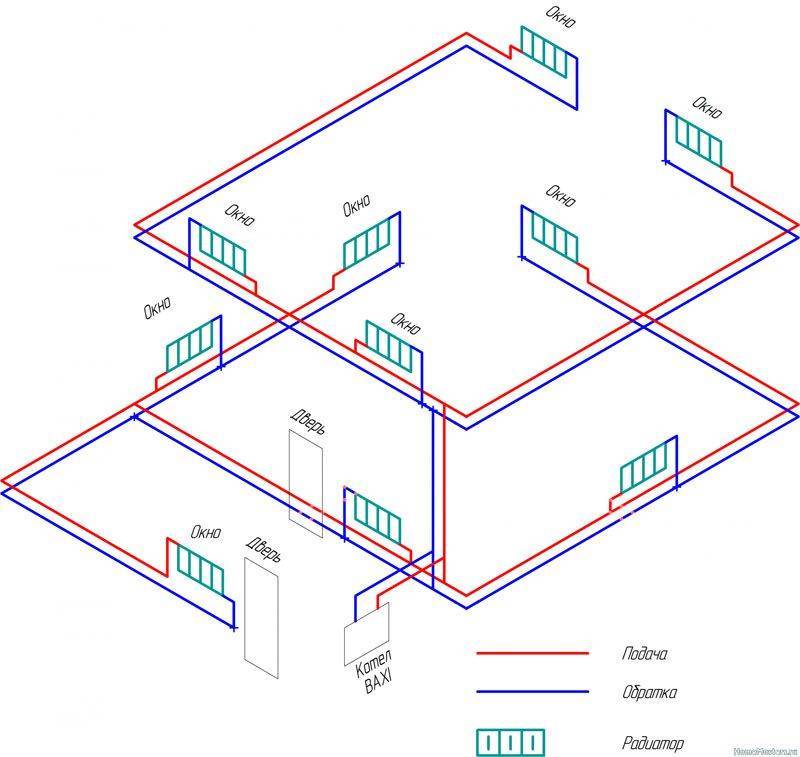

A double-circuit circuit allows you to better warm up all rooms
Scheme of water heating of a two-story house
When installing a system in a two-story building, a gravity flow scheme is rarely chosen. Here, the best choice is water heating in a private house with forced circulation. The contour can be one-, two-pipe or radial.
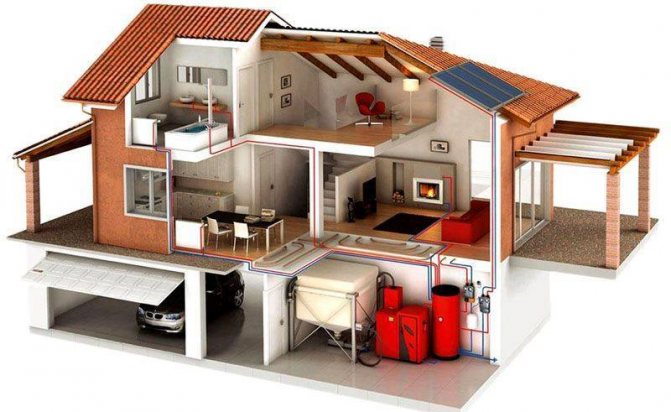

The scheme is selected individually
Collector circuit for heating a one-story house with forced circulation
The collector (beam) water heating system includes a collector, which is a device used to collect the coolant. Two pipes are connected to each radiator: direct and return. Such a heating scheme with forced circulation of a one-story house allows you to best hide the pipes being laid. Moreover, each room may have its own temperature.
A special cabinet is used to accommodate the collector. The disadvantage of this scheme is the increased cost due to the need to purchase new equipment.
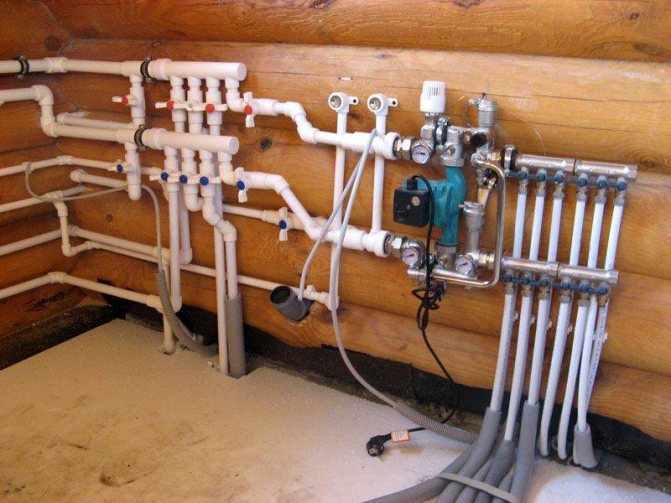

The collector circuit is expensive
Gravitational heating schemes for a one-story and two-story house
Several options for connecting devices for one-pipe heating
If it is planned that gravitational heating under pressure will be installed in a one-story house, you can use the one-pipe scheme "Leningrad".
A feature of this scheme is one pipe to which several heating devices are connected in parallel. However, this leads to an uneven distribution of heat - the further the radiator is from the boiler, the lower the temperature of the water entering it. To solve this problem, you can upgrade the closed-type gravitational heating system:
- Installation of valves. With its help, you can reduce the volume of the coolant for heating devices located closer to the boiler. Thus, the heat output of energy in the first sections of the system will decrease;
- Increase the number of radiator sections with distance from the boiler;
- Install pipes of a larger diameter at the point where the branch pipes are connected to the heating devices. This will reduce the gravitational pressure of the heating system in this area, which will reduce the speed of water circulation in the radiator.
Such a scheme is acceptable for a small length of the highway. However, it is not recommended to install it for a two-story house. In this case, a two-pipe branched gravitational heating system will be required, the calculation for which is performed on separate sections.
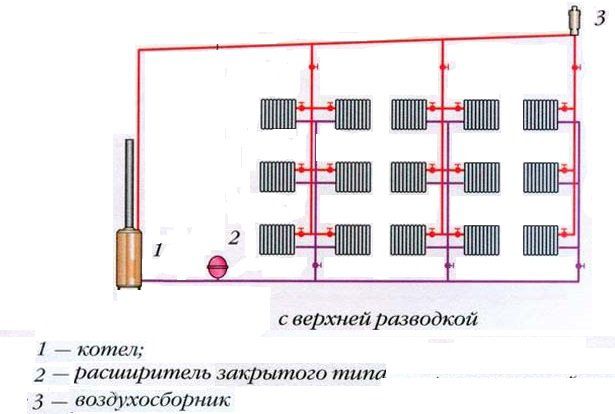

Gravity system with top routing
Its peculiarity lies in the fact that separate circuits lead to the central pipe located in the upper part of the line. Heating devices are connected to each of them. It is important that they are the same length. Otherwise, all the liquid will rush into the area of least resistance - into a short circuit.
To prevent the movement of the coolant to the outlet of the boiler, a gravity check valve is installed for heating. This is an indispensable element for the gravitational heating system of a two-story house.
Installation diagrams of a heating system in a private house
In practice, two types of systems are used - schemes (or types of pipe routing), namely:
- one-pipe;
- two-pipe.
Each of them has its own advantages, disadvantages and is used in different cases.
One pipe system
This type of wiring is cheaper and simpler. The system is built in the form of a ring - all the batteries are connected in series with each other, and hot water moves from one radiator to another, then enters the boiler again.
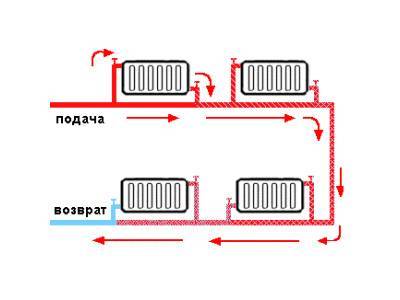

As you can see in the figure, all the batteries are connected in series, and the coolant passes through each of them.
This heating scheme is very economical in its execution, it is simple to install and design. But it has one significant drawback. It is so weighty that many refuse such a wiring and prefer the more expensive and complex two-pipe. The problem is that as the coolant advances, it will gradually cool down. Until the last battery, the water will flow slightly warm. If the power of the boiler is increased, then the first radiator will heat up the air too much. This uneven distribution of heat makes it necessary to abandon a simple and cheap one-pipe system.
You can try to get out of a difficult situation by increasing the number of sections of the last radiator, but this is not always effective. Hence, the conclusion suggests itself that one-pipe wiring can be used when the number of batteries connected in series is no more than three.
Some people get out of the situation as follows: they connect a pump to the boiler, thereby forcing the water to move forcibly. The liquid does not have time to cool down and passes through all radiators, almost without losing temperature. But even in this case, some inconveniences await you:
- the pump costs money, which means that the costs of installing the system increase;
- electricity consumption increases, since the pump is powered by electricity;
- if the electricity is cut off, there will be no pressure in the system, which means there will be no heat either.
Output.The one-pipe system is effective only for small houses with 1-2 rooms, where a small number of radiators are used. Despite its simplicity and reliability, it does not justify itself in country houses, where it is necessary to install more than three radiators for the entire living space.
Two-pipe system
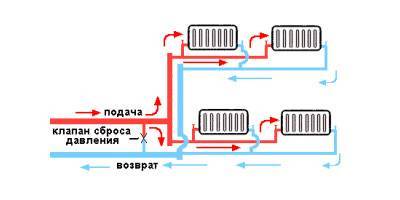

Hot water is supplied through one pipeline, and cooled water through another. This ensures an even distribution of heat across all batteries.
Such a heating distribution in a private house will be much more efficient and better than a one-pipe one. Although it is more expensive to perform and more difficult to install, it allows you to evenly distribute heat across all batteries, which will help create a comfortable environment. Unlike a single-pipe, in this wiring, a hot water pipe is supplied under each radiator, and the cooled liquid goes down the return line to the boiler. Since the coolant is supplied to all batteries at once, the latter heat up equally.
This system is not much more complicated than the first, you will have to buy more materials, since pipes will have to be supplied to each radiator.
A two-pipe system can work in two ways:
- collector;
- ray.
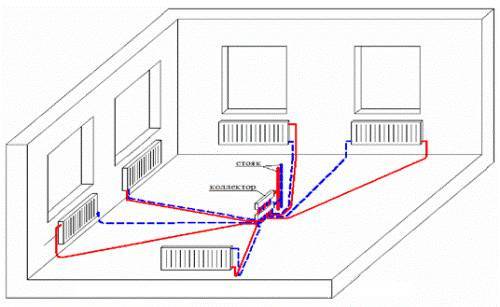

The ray wiring is older. In this version, the supply pipe is installed at the top point of the house, after which piping is done for each battery. Thanks to this design, the circuit was named - ray.
The first scheme works as follows: in the attic it is necessary to install a collector (a special device consisting of many pipes), which distributes the coolant through the heating pipes. In the same place, you need to install shut-off valves that will cut off the circuits. This design is quite convenient, it facilitates the repair of the entire line and even a separate radiator. Although the scheme is reliable, it has one significant drawback - a complex installation with a large amount of materials (shut-off valves, pipes, sensors, control devices). The collector wiring diagram for heating pipes is similar to the radial one, but more complex and efficient.
Unlike a one-pipe system, a two-pipe system does not need additional forced circulation of the coolant. It shows high efficiency even without a pump.
Bilge and ballast ship systems
Bilge systems... A group of systems designed to remove overboard water that accumulates in the compartments and holds during the operation of the vessel due to leaks in the joints of the hull plating and pipes, sweating, as a result of washing the interior, as well as for removing a large mass of water from the ship's premises overboard , received during an accident, damage to the case or extinguishing a fire. These include drainage, drainage and bypass systems.
According to the Rules of the Register of the USSR, any vessel must be equipped with a drainage system, and an independent drainage system is necessarily used only on sea passenger ships. Emergency drainage on small vessels (boats, tugs, etc.) is carried out by a drainage system, and on transport ships - using a ballast system. Emergency drainage from marine vessels is carried out by cooling pumps of the main engines, the capacity of which must be sufficient for this.
When designing bilge systems, the following requirements are imposed: the bilge water system must ensure the removal of bilge water from any compartment with allowable heel and differentiation of the vessel; at least two receiving branches, located on different sides of the vessel, must be introduced into each drained compartment; self-propelled marine vessels must have at least two bilge pumps with an independent mechanical drive; water pipelines, as a rule, should not pass through ballast and fuel tanks; bilge systems should be designed in such a way thatto exclude the possibility of seawater entering through their pipelines inside the vessel, as well as the overflow of water from one compartment to another. For this, non-return valves should be installed on the pipelines.
The drainage system is used for the day-to-day removal of water that accumulates in the lower parts of the ship's hull during normal operation. With its help, the remaining water is pumped out, not removed by the drainage, ballast or fire systems. The drainage system consists of receivers, suction and discharge pipelines with non-return or non-return shut-off valves. The receivers are equipped with protective screens to prevent dirt from entering the system. Receivers are installed in double bottom collecting chambers, bilges and other similar places.
The bilge pumps are placed in different watertight compartments. Hand-operated piston pumps, fire line ejectors, or a bypass system are used to drain small-volume compartments. In the drainage system, centrifugal pumps are used with a flow rate of 15–400 m3 / h and a suction head of 5–6 m.
The pipelines are made of steel pipes with an internal protective coating (galvanized, lined). The diameter of the pipes depends on the dimensions of the vessel and the length of the compartment to be drained.
In fig. 5.33 shows a diagram of an autonomous system for draining the bow of the ship.
Fig. 5.33. Diagram of an autonomous system for draining the bow of the ship
The water accumulated in the skipper's 5 is taken by the ejector 3 through the grids of the sewers 4 and the non-return valves 2. The water from the chain box 1 flows to the ejector through the non-return valves.
In drainage systems, portable and stationary submersible pumps are used with a flow rate of up to 630 m3 / h. Due to the rare commissioning of drainage systems, they are often combined with ballast systems. When stationary and portable water-jet ejectors are used for drainage and drainage, the working water is supplied to them from the water fire extinguishing system. The drainage system should ensure the removal of water at a specified time from the watertight compartments of the ship after filling holes. The supply of drainage agents is determined by the specified drainage time from the largest compartment, flooded to the waterline level at the highest draft of the vessel.
The drainage system piping must have a large diameter, be independent of the drainage system piping, and must be designed so that the compartments cannot be flooded through it, even if damaged. For this, the valves on the outgrowths going into the compartments must be of the non-return-shut-off type and be remotely controlled from the bulkhead deck and from the installation site. On the main pipeline, valves must be provided to shut off individual damaged sections.
The drainage rescue system for pumping water from the flooded compartments of the damaged ship is shown in Fig. 5.34.
From the drainage pump 2 of the rescue ship 11, a riser leaves to the deck line 8 with a clinket 1, on which two-valve boxes are installed 7. They are connected to onboard pipelines 9, ending with quick-release nuts 6, with the help of which emergency hoses 10 are connected. The hoses are thrown onto the deck of the damaged ship 12 and lowered into the flooded compartment. Water from the compartment through the intake screen 13 is taken by the pump 2 and through the drain pipeline 3 through the non-return valve 4 and Kingston 5 is removed overboard. Piston or centrifugal pumps equipped with a self-priming device are used as rescue pumps.
The bypass system is used in rooms (radio rooms, cellars, fire extinguishing stations, etc.), which are impossible or inconvenient to equip with a drainage system. It consists of drain pipes through which water is discharged to the lower compartments served by a drainage system. There are no pumps in this system.Remote or automatic control using a bypass or drain valve. With automatic control, the valves open if the water in the compartment rises to a certain level.
Fig. 5.34. Drainage Rescue System Diagram
- Ballast systems
Boiler selection
for water heating in the country depends on the variety of energy sources available in the summer cottage. If the dacha association has a gas main, then the boiler, respectively, is better to choose a gas one - this is the most economical option. Also, the boiler can be electric, or run on diesel fuel, or coal.
It is worth paying attention to the fact that boilers are single-circuit - designed only for heating the room, and double-circuit - they can cope not only with heating a country house, but also used to heat water
An example of a solid fuel heating boiler with a water circuit.
In a country house, the wiring can be made open, or hidden under the floor, which will help to equip the heated floors that are very popular nowadays. If the house is only at the stage of construction, then it is preferable to place the heating system under the floor. And if the house is already ready, then the pipelines are mounted along the inner walls.
Installation
Effective water heating in the country can provide for two types of piping:
with a vertical riser - all systems are connected to a single riser;
with horizontal drain.
The horizontal scheme is better than other options in terms of self-installation, and cheaper to install, but there is a threat of air accumulation and air congestion. The horizontal type is also used for the installation of warm water floors.
Features of the installation of water heating
The use of water as a heat carrier is due to the fact that this liquid has a very good heat capacity and is able to effectively receive and give off heat. Water heating has been used in homes for a long time. Since then, the principle has remained the same, but the heating element connection diagrams have undergone major modernization. Nevertheless, for the construction of water heating, all the same materials and devices are used as a hundred years ago, only improved ones:
- power plants. They can be stoves or boilers that run on electricity or gas;
- pipes of various diameters. Today, in addition to metal pipes, plastic and metal-plastic pipes are actively used;
- heating radiators, which are made of cast iron, steel or aluminum;
When buying radiators, choose trusted manufacturers
- various shut-off valves, without which it is impossible to build water heating of a private house with your own hands. Its connection diagram is quite simple;
- expansion tank to compensate for excess pressure in the system;
- circulation pump, which is included, for example, in the heating circuit of a one-story house with forced circulation.
This is an almost exhaustive list of the equipment that is needed in order to make water heating of a private house with your own hands. There are three schemes for installing and connecting radiators:
- Using one pipe.
- Using two pipes.
- Using collectors.
One-pipe heating system with circulation pump
According to the type of coolant supply, all schemes can be divided into heating with a natural water flow and forced. Natural circulation is carried out due to changes in water temperature. The hot liquid rises, since it has a lower density, and the cold one flows downward. Forced circulation occurs due to pumps that are installed in the pipeline or located directly in the boiler.
A stove with a water circuit for heating a house: options for implementation. Stove heating, heating and cooking stoves, fireplace stoves, advantages, design, implementation options. Calculation, materials, installation.
What features must be taken into account in the project "Leningrad".
It is best to consult with a professional builder when designing a single tube ring system. If this is not possible, it is necessary to familiarize yourself with a large number of materials on this issue. To do this, you can use various specialized Internet sites, videos and books, which can also be downloaded via the Internet.
A feature of the gravity "Leningrad" are large-diameter pipes, and the total length of the line should be less than 30 meters. Otherwise, normal circulation of the coolant should not be expected. To help free circulation, the supply pipe is mounted with a slight slope, but at the same time the radiators are at the same height so as not to disturb the geometry of the space and look aesthetically pleasing.
If you have a vertical layout of the heating system, then you can do without a circulation pump, which is necessary for a horizontal one. The choice of additional equipment for the heating main must also be approached with responsibility. In order to be able to regulate the temperature in individual parts of the system, it is necessary to use needle taps. Ball valves, if partially opened, quickly fail and you will need to stop the system to replace.
"Leningradka" has been tested for more than a dozen years. It is a truly economical and time-tested system that is effective. Currently, the classic gravity "Leningrad" was transformed into a more perfect system using a circulation pump and needle taps. Boilers have also undergone significant changes and now use gas and electric models to create line temperature maintenance. Using an already proven system, together with modern technologies, will allow you to install a high-quality heating system that does not require labor and investment.
The article turned out to be difficult for perception, but it does not contain all the subtleties for design and installation, only general information. Who has mastered the article to the end and who has any questions or simply does not understand the above, write in the comments.
One pipe connection
Installation of heating using the one-pipe method is the least expensive, at the same time, wiring in two pipes will be most effective, especially if the rooms in the house have a large area. The advantages of this scheme are as follows:
- Ease of installation and repair;
- Profitability;
- Possibility of laying the line at floor level;
- Use of the system in a one-story and two-story house;
- Possibility of forced or natural circulation.
With a one-pipe system, water moves from one radiator to another through the pipe, and upon reaching the last radiator it cools down a lot. Such a system does not lend itself to adjustment.
Connection options.
Installation Recommendations
The slope of pipes in a gravitational heating system
Having completed the calculation for a gravitational heating system made of polypropylene or steel pipes, you can proceed with its installation. To achieve optimal efficiency, experts recommend making small but important changes to the standard scheme:
- Slope of highways... The optimum gravitational pressure for the heating system can be achieved by the slope of the pipes after the air vent and on the return pipe after the last heating device;
- Installation of a circulation pump on the bypass... It will help to reduce the inertia of the system. The time for heating the coolant can be very long, so the pump can increase the speed of its movement along the line until the desired temperature regime is reached;
- Minimum turning points in the pipeline... They create unnecessary hydraulic resistance, which affects the decrease in the speed of water movement;
- Installation of protective elements... By installing a check valve for gravity heating, it is possible to avoid water circulation in the wrong direction. This is especially necessary for a system with top routing and multiple circuits.
The main components of a properly made gravity heating under pressure are professionally calculated preliminary calculations, selection of the right materials and adherence to installation technology. This will make it possible to create an effective system for maintaining a comfortable temperature in the house.
Tips for arranging and using a gravity valve for heating when installing a warm floor, additional elements, can be seen in the video:
Application of gas boilers
Boilers used in a water system can use a variety of fuels. The most common and convenient to use is gas equipment - although it can be installed only when the central gas supply is connected to the house. In addition, among the disadvantages of gas boilers can be called the need for their regular monitoring by the relevant utilities.
But such a system has the following advantages over the others:
- Easy to install and operate.
- High efficiency in the use of energy resources. On average, gas costs are 30–40% lower than using liquid fuels or electricity.
- Rapid heating of premises with a heat carrier. Within an hour, the temperature in rooms with a hot water heating system, the source of heat in which is a gas boiler, will increase markedly.
- Environmental friendliness of gas use.
- The ability to automate the process, including programming the required temperature and heating hot water.
How to make water heating of a private house with your own hands - a step by step diagram
Step 1: Project
First, we choose a suitable scheme and display it on paper. Consider the area of the rooms, the position of the radiators, piping, their dimensions, etc. Such a sketch will help to correctly calculate the amount of consumables. Special programs will greatly simplify all calculations.
Step 2: accessories
Let's briefly consider what a boiler, batteries and pipes can be. The types of heating units, depending on the fuel used, are gas, electric, solid fuel and combined. The favorite among these options can rightfully be called gas devices. Water boilers come with a pump (for a forced heating circuit of a private house) or without it (natural circulation), and both types can be easily installed with your own hands. The double-circuit unit has proven itself perfectly, providing not only heat in the house, but also hot water.
Steel batteries will please the price, but at the same time they are susceptible to corrosion, and if you plan to drain the coolant, then the operating life will be significantly reduced. Cast iron, on the other hand, can be said to be an eternal material. It heats up for a long time, but it also keeps warm for a long time. But the large weight, not too attractive appearance and high cost have significantly reduced the popularity of this material. Cast iron batteries were replaced by aluminum ones. Their appearance is very attractive, they heat up quickly and are resistant to corrosion. However, aluminum does not tolerate sudden changes in pressure. Bimetallic resistors are famous for their excellent heat transfer, however, the anti-corrosion properties remain the same as those of aluminum.
The steel pipeline has lost its former glory due to its short operational life. It was replaced by modern polypropylene. Easy installation, the ability to create a "one-piece" structure, reasonable cost and reliability - all these are indisputable advantages. Copper pipes also have good characteristics, but their cost is far from affordable for everyone.
Step 3: boiler
Water heating in a private house is built in such a way that the medium is heated by the boiler. This scheme is the most optimal in the absence of a centralized supply. Therefore, when choosing a place where to install the boiler, one should take into account the location of the gas pipeline inlet or the presence of electrical wiring. If we are talking about a solid fuel unit, then you need to make additional installation of the chimney. If you prefer the natural circulation of the coolant, then position the heating unit so that the return flow inlet is as low as possible. In this case, the basement is ideal.
Step 4: Installing radiators
The batteries are placed under windows or near doorways. The design of the mount depends on the material of the resistors and the number of sections. The heavier they are, the more reliable fixation they need. A gap of at least 10 cm should be left between the radiators and the window sills, the floor should be more than 6 cm. By installing shut-off valves on each element, you will be able to regulate the amount of coolant in the batteries, and the air valve will help to avoid unwanted traffic jams.
Step 5: Layout
The boiler will be the starting point for piping installation. In this case, one should adhere to the scheme chosen and sketched on paper. If the pipes are visible, then we are talking about open wiring. On the one hand, the aesthetic side suffers, but on the other hand, any leak will remain visible, and in order to replace the damaged element, you do not need to disassemble the box. The pipeline can also be hidden, walled up in the wall, made of plasterboard cladding, etc. At this stage, batteries, additional equipment (pump, filters, security unit, expansion tank, etc.) are connected.
DIY heating system installation
Installation work should be started with the installation of the heating boiler. If the power of the equipment does not exceed 60 kW, you can put the device in the kitchen, if it is higher, a separate room should be allocated for the boiler. To heat sources that burn different types of fuel, you need to ensure the flow of air. In addition, it is necessary to ensure the removal of combustion products. This can be done using a properly equipped chimney.
When installing a heating boiler, certain rules must be observed. The distance to the nearest equipment and walls should be at least 0.7 m. The piping of units that run on different types of fuel is practically the same. The figure shows a variant of piping a gas boiler with a forced circulation system.
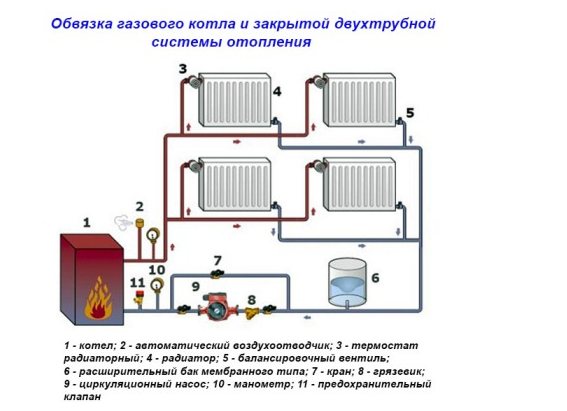

This strapping method is used most often. Other schemes provide for the presence of their own pumps to ensure continuous circulation of the heated coolant.
If solid fuel heat generators are used to service the heating system, when connecting them, the following nuances must be taken into account: due to the inertness of the device, the coolant may overheat and boil. To avoid unpleasant situations, it is necessary to install a circulation pump on the return. An additional security system is also mounted, which consists of the following elements:
- safety valve;
- automatic air vent;
- pressure gauge.
An important function is performed by a safety valve, because it is he who is responsible for relieving excess pressure in cases where the coolant overheats. The most effective piping scheme for a solid fuel boiler is shown in the figure below.
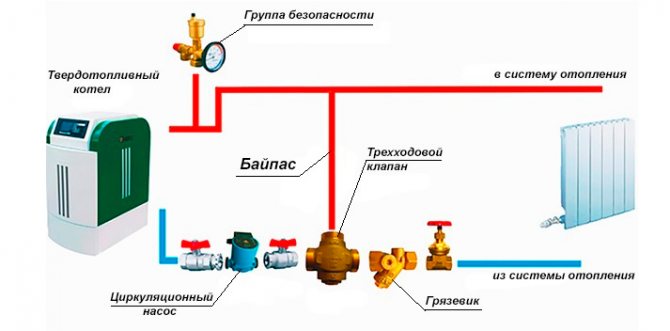

Another problem that is often encountered when operating a heating system on solid fuel boilers is the accumulation of condensate on the elements of the unit. This happens due to the ingress of cold water with a hot cut. To prevent condensation of the coolant, a three-way valve and a bypass are installed in the systems.
Installation of heating pipes
It is impossible to equip a heating system in a private house without a pipeline.In old houses, there are cast iron pipes from the last century. They boast a long service life, durability and reliability. However, today such products are used extremely rarely, because they are almost completely replaced by lighter, more convenient and cheaper pipes, which can be made from the following materials:
- steel;
- copper;
- stainless steel;
- polypropylene;
- polyethylene;
- metal-plastic.
The advantages of the Leningradka heating system.
The cost of installing such a system is reduced due to the fact that the principle of one pipe is observed, that is, there are completely no elements that are responsible for the disposal of waste water. Among the advantages of the system, thanks to this feature, we can note:
- Low maintenance and material costs;
- The possibility of construction even by a non-professional craftsman;
- Pipes can pass along any path most convenient for installation;
- Aesthetic appearance of the finished heating system;
- Possibility of connecting several boilers to the system.
Most often, the pipe is mounted along the perimeter of the building (along the outer walls). All radiators and underfloor heating systems are connected to the heating boiler. Water, as a heat carrier, goes full circle through the system and through another inlet is again supplied to the original boiler.
"Leningradka" - heating system

